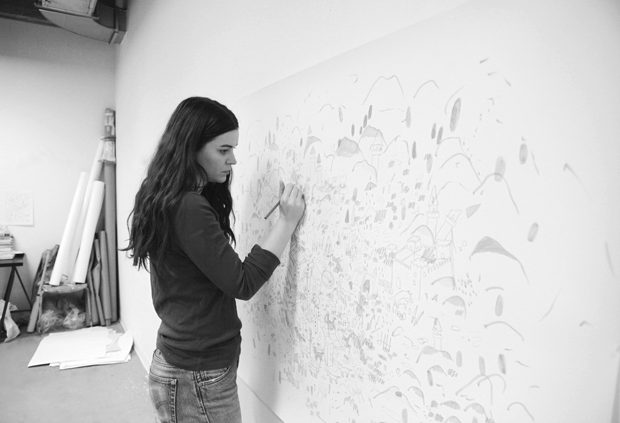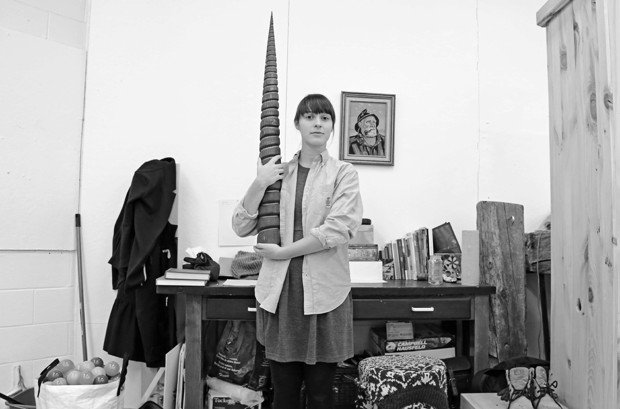From soapmaking to a crank-operated turnstile
 For Rebecca Munce, a summer artist residency “is the ideal situation.”
For Rebecca Munce, a summer artist residency “is the ideal situation.”
This summer, two artists are undertaking a paid residency at the FOFA Gallery, thanks to the Young Canada Works student employment program. Alumna Steffie Bélanger (BFA, 13) who is pursuing graduate studies at UQAM, and Rebecca Munce, a current MFA candidate in Studio Arts, began creating art in the university’s gallery spaces on July 11 and will continue until August 26.
The artists-in-residence can be found weekdays from 11 a.m. to 5 p.m. on the ground floor of Concordia’s Engineering, Computer Science and Visual Arts Integrated Complex (EV Building), and they encourage the public to stop by to view their work in progress.
NOW News had a chance to speak with Belanger and Munce about their practice, inspirations and how it feels to be valued for their artistic labour:
Q&A with the artists
Steffie Bélanger suggests that art objects are fundamentally yet wonderfully useless. As such, her sculptures adopt interactive and operational qualities, but are ultimately dysfunctional, their actions leading nowhere.
What are you working on right now?
SB: I’ve just started writing my master’s thesis after completing two intensive years of study. The theme of my paper is machine romantique and how the body acts as a performative instrument in my sculptures. In studio, I’m working on a piece that functions like a kind of crank-activated turnstile with several small pieces of tissue integrated as a handle. The idea is to produce a simple and delicate movement with such a conspicuous device. I’m interested in the concept of futility in any given object.
How did you get here?
SB: I was in search of a summer job so when I found out about the theme of this particular residency, I was intrigued — it seemed too good to be true! I think that the project is consistent with my practice — making unnecessary, but functional items in an environment framed by the standards of a typical employee (5 days a week, 9 a.m. to 5 p.m.). I also particularly enjoyed my years of study at Concordia and was a bit nostalgic for the university atmosphere. So I submitted my application and crossed my fingers. And here I am!
What has your attention artistically?
SB: This is a difficult question because many things attract my attention these days. As a master’s student, I’m interested in old books on body mechanics, but I also have a fascination with traps in general (their work, their aesthetic, the fact that they are camouflaged in their environment). In this respect, I loved the Mathieu Lefevre Make It Big retrospective exhibition at the Centre Clark. There was a video and poster about how to catch a collector that I enjoyed immensely.
 Steffie Bélanger’s creative process is both in-depth and contemplative.
Steffie Bélanger’s creative process is both in-depth and contemplative.
What communities do you feel most connected to or engaged by?
SB: My family has a dairy farm and a sugar bush in the Laurentians. It was there where I started woodworking, which was part of my family’s ancestral work, as it not only kept the forest healthy, but wood cut lengthwise could be stored in barns for firewood. My commitment to the craft is more sentimental than political.
What can we expect to see from you at the FOFA Gallery?
SB: I have a lot of project ideas running through my head and I'll take the opportunity to produce as much as possible. Some constraints also force me to use materials other than wood, which I hope will be positive for my practice. Otherwise, more specifically, I would like to produce a series of sculptures that demonstrate the methodology used during my production, from the idea to the final piece.
Rebecca Munce extracts everyday situations and familiar objects from the world around her and recontextualizes them using drawing, felting and soap-making techniques. Her pastel-coloured palette and candy-coating methodology cloaks the detailed depictions of mundane and sometimes horrific narratives.
How did you get here?
RM: I grew up in Scarborough and went to York University for my bachelor’s. I stayed in that area of Toronto for the most part until I came here to do my MFA at Concordia.
What has your attention artistically?
My attention can vary but I find generally I'm attracted to quiet craft pursuits and sharing narratives which can sometimes result in writing.
What communities do you feel most connected to or engaged by?
RM: I enjoy the theatre a lot, as well as poetry readings and going to see live music. I connect with communities that make an effort to connect with me. I'm engaged mostly by the act of storytelling.
What can we expect to see from you at the FOFA Gallery?
RM: I'm looking at soapmaking in conjunction with felting and drawing. I find it’s following the narrative of the touchable or usable object. I'm interested in using materials found in everyday life to explore familiar or intimate relationships the viewer may have with such objects. Drawing has always carried notions of the familiar. Soapmaking and felting are opportunities for object-oriented extensions of that initial two-dimensional notion.
Read more about the FOFA Gallery’s Artists at Work residency.


